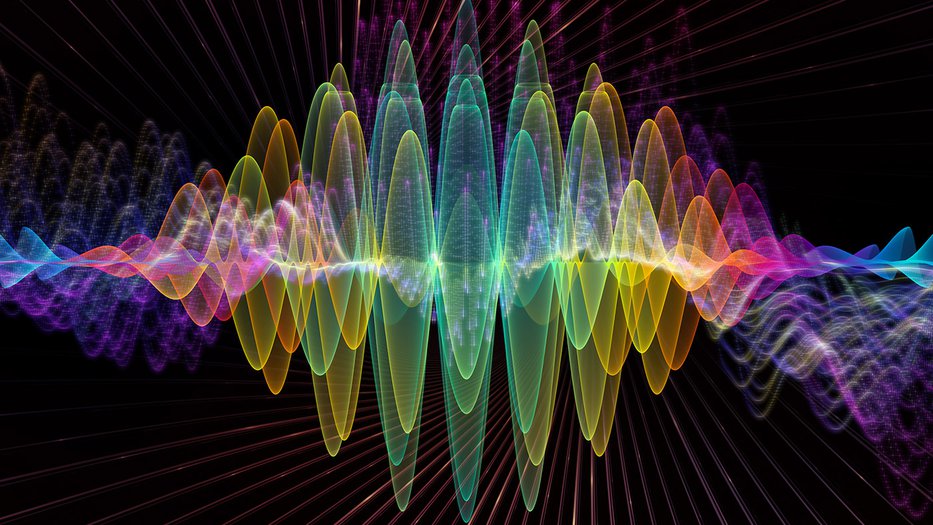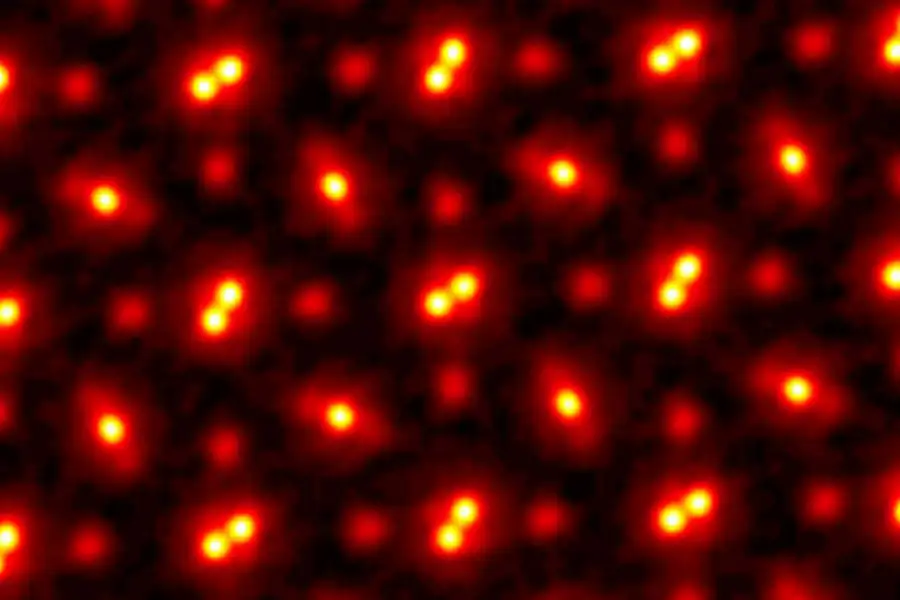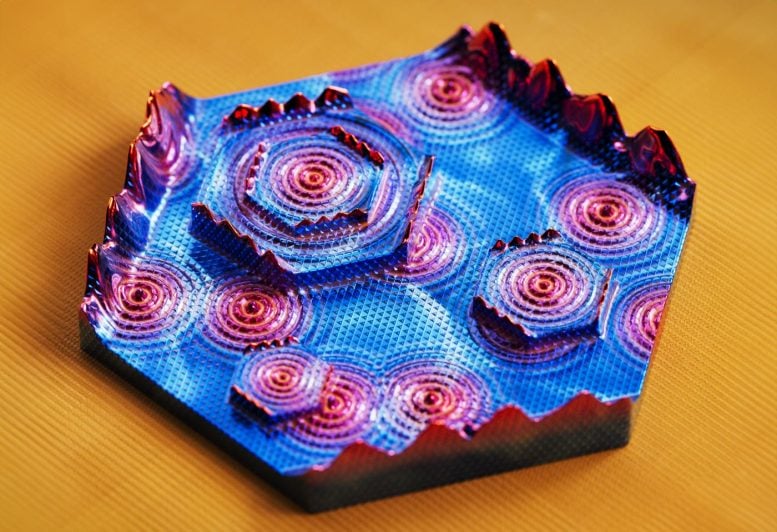
Quantum physics, the world of molecules, atoms, and their components, is a relatively new study area, at least when it comes to being called quantum. Research helps produce new technologies that will enable the development of molecular computers and other products. The following is an announcement of a breakthrough.
“A novel quantum state, “hybrid topology,” was discovered in arsenic crystals by Princeton scientists, merging edge and surface states in a unique quantum behavior. This groundbreaking finding, revealed through advanced imaging techniques, makes a significant leap in quantum material research and has implications for developing new quantum devices and technologies.1
While exciting to many, I needed to break this down to understand it. So, I started with what I knew. I remember hearing about this field of study in Star Trek years ago, and now I want to start there. Here is the quote from that episode.

RAYNA: At last, I have seen other humans.
FLINT: Other men.
RAYNA: One is not human.
FLINT: The Vulcan.
RAYNA: Oh, so that is a Vulcan. I want to discuss sub-dimensional physics with him. You’ve taught me all you know about the area, and you say Vulcans know more.
FLINT: Even he is not your intellectual equal, nor mine.2
Even when I first saw this episode (one afternoon after school) I knew what they were discussing. The atom had been not only hypothesized but very closely observed but not quite seen.
“The basic idea that matter is made up of tiny indivisible particles is an old idea that appeared in many ancient cultures. The word atom is derived from the ancient Greek word atomos, which means “uncuttable”. This ancient idea was based in philosophical reasoning rather than scientific reasoning. Modern atomic theory is not based on these old concepts. In the early 19th century, the scientist John Dalton noticed that chemical substances seemed to combine with each other by discrete and consistent units of weight, and he decided to use the word atom to refer to these units.”3
From there, we found that it was more complicated. “The first breakthrough came in the late 1800s when English physicist Joseph John (JJ) Thomson discovered that the atom wasn’t as indivisible as previously claimed. He carried out experiments using cathode rays produced in a discharge tube and found that the rays were attracted by positively charged metal plates but repelled by negatively charged ones. From this, he deduced the rays must be negatively charged.”4
So, scientists studied the components of the atom in earnest. These studies gave ideas to screenplay writers.

The Marvel movies Ant-Man and the Wasp 2018 and Ant-Man and the Wasp -Quantumania 2023 contained an idea of exploring this part of our world5. The characters go to the Quantum Realm, and it was great. Mixing digital graphics and real human beings in this movie was done well and colorfully. The first movie had a character who got lost in the quantum realm, and most of the film’s action focused on rescue, while the second movie dealt with the whole family of characters going back down into that miniature world. The quantum level also touched the villain, who, as a result, changes phases and acts like a ghost going through walls and people by changing phases (phases are states of matter like ice, water, and steam). The movie explores this world, but much of it is fantasy. You would not find life as we know it in the sub-atomic world; how would they breathe? Oxygen molecules would be giant. However, this quantum world has a very different physical environment from our own, which does have changing phases of matter.
There is one problem, though. “A jarring divide cleaves modern physics. On one side lies quantum theory, which portrays subatomic particles as probabilistic waves. On the other lies general relativity, Einstein’s theory that space and time can bend, causing gravity. For 90 years, physicists have sought reconciliation, a more fundamental description of reality that encompasses quantum mechanics and gravity. But the quest has run up against thorny paradoxes.”6
In other words, matter acts differently in our world than in the tiny world of subatomic particles, and of course, the experts argue about why. They are all guesses, but answers are beginning to be seen.
So, go back to basics.
What does quantum mean? It’s a noun that means:
1. The smallest amount of a physical quantity that can exist independently, especially a discrete quantity of electromagnetic radiation.
2. This amount of energy is regarded as a unit.
3. A quantity or amount.6
This word encompasses all that world, much about which we have yet to hypothesize. We know some of these components from years of study and observation. The atom, the fundamental unit of matter, has a nucleus. This nucleus contains protons (+ charge), neutrons (neutral or no charge), and electrons ( – charge) that orbit around the nucleus. These particles are made up of other particles: photons, gluons, quarks, muons, and tao. These particles contain different percentages of matter and energy. All of this data is deduced, not seen.
Atoms, though, have been seen. The significant discovery at the beginning of this blog is about advanced imaging techniques. This refers to a new variation of an electron microscope that uses a stream of electrons to show small things’ structure. This technology has undergone some incredible advances, but the actual test is what it can see. “The highest-resolution image of atoms so far has been captured, breaking a record set in 2018. David Muller and his colleagues at Cornell University in Ithaca, New York, captured this image using a praseodymium orthoscandate crystal.”7

What is topology as it relates to the quantum realm?
Topology is the branch of mathematics that explores the nature of shapes independent of deformation. For instance, an object shaped like a doughnut can be deformed into the shape of a mug, so that the doughnut’s hole becomes the hole in the cup’s handle. However, the object couldn’t lose the hole without changing into a fundamentally different shape.8
The translation is that it is the study of shapes that stay their core shapes even if messed with.
Employing insights from topology, researchers developed the first electronic topological insulators in 2007. Electrons zipping along the edges or surfaces of these materials are “topologically protected,” meaning that the patterns in which the electrons flow will stay unchanged in the face of any disturbances they might encounter.”8
My interpretation? A substance can have electrons run along its edges or surfaces predictably, and the electron’s route and topology of the material it runs around stays the same. In other words, the substance provides predictability of electron flow.
What is a hybrid topology?
“A hybrid topology is a network architecture that links two or more duplex network topologies. Three hybrid topologies are the mesh, bus, and ring topologies. Thus, the definition of hybrid topology is the main topic here. The deployment of the planned networks, the number of computers, and their location are only a few examples of variables that affect the usage and selection of the topology. A hybrid topology is a topology that combines two or more other topologies, to put it simply.”9
Adding in what the hybrid comprises: a network of topologies.
A definition of these network typologies: a noun
1. The physical arrangement of a network; how cables are arranged to connect computers in a network.
2. The configuration of a communication network.9
I had trouble getting through that, but it can be illustrated by this picture:

The discovery suggests we can use networks of different topologies, in this case, edge states and surface states, on specific substances (here, crystalline arsenic As) for electron transport channels.
Translation: Arsenic in this crystal form had a hybrid topology that electrons could run through predictably.
That calls for two more definitions:
Surface states are electronic states found at the surface of materials.10
Edge states are the topologically protected electronic states that exist at the boundary of the material and cannot be removed without breaking the system’s symmetry.11

This illustration is the representation of data visualization of quantum states of electrons on the surface and edge of grey arsenic crystal obtained using a scanning tunneling microscope at Princeton’s physics department.
Translation: Using the data the picture was produced to show what the surface would look like.
So, this substance, and others we haven’t found yet, can enable the design of new quantum information science or quantum computing devices. Such a leap means more efficient, faster computers, also called molecular computers—a step purported to usher in the Singularity.
The term Singularity describes the moment when a civilization changes so much that its rules and technologies are incomprehensible to previous generations. Think of it as a point-of-no-return in history.12
The BIG CHANGE!
©JM Strasser 2024 All Rights Reserved
Footnotes
1. https://scitechdaily.com/elemental-surprise-physicists-discover-a-new-quantum-state/
2. http://www.chakoteya.net/StarTrek/76.htm
3. https://en.wikipedia.org/wiki/History_of_atomic_theory
4. https://www.compoundchem.com/2016/10/13/atomicmodels/
5. https://www.imdb.com/list/ls566143753/
8. https://spectrum.ieee.org/a-beginners-guide-to-topological-materials
9. https://www.zenarmor.com/docs/network-basics/what-is-hybrid-topology
10. https://en.wikipedia.org/wiki/Surface_states
11. https://en.wikipedia.org/wiki/Edge_states
12. https://gizmodo.com/what-is-the-singularity-and-will-you-live-to-see-it-5534848
Illustrations
1. https://scienceexchange.caltech.edu/topics/quantum-science-explained/quantum-physics
3. https://ewscripps.brightspotcdn.com/dims4/default/3fe5b71/2147483647/strip/true/crop/1280×720+0+0/resize/1280×720!/quality/90/?url=http%3A%2F%2Fewscripps-brightspot.s3.amazonaws.com%2Fb0%2Fd1%2Fe22408484df2bb084ad562d2b2c9%2F1676579953-iyzs5w.jpg
5. https://www.zenarmor.com/docs/network-basics/what-is-hybrid-topology
6. https://scitechdaily.com/elemental-surprise-physicists-discover-a-new-quantum-state/